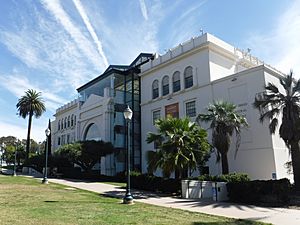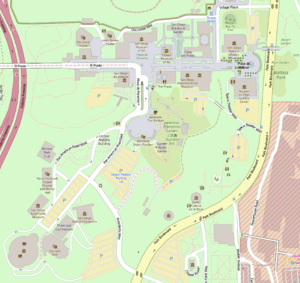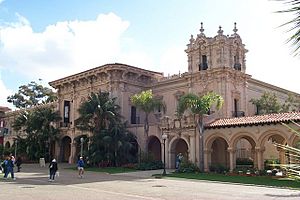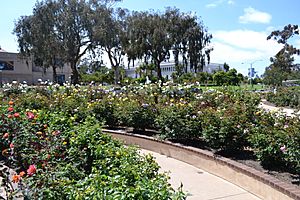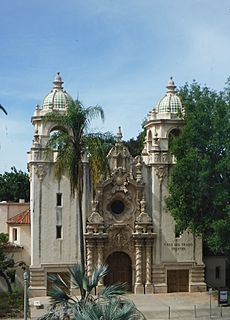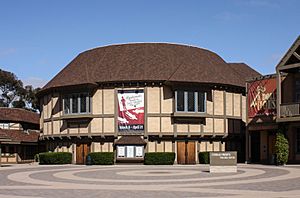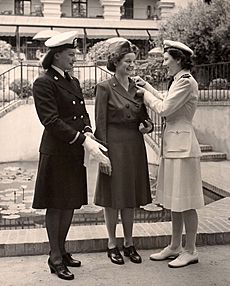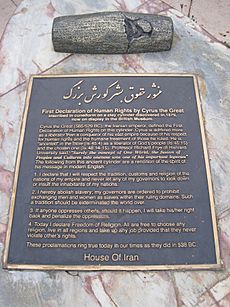Balboa Park (San Diego) facts for kids
|
Balboa Park
|
|

El Prado, by the Casa Del Prado and several museums.
|
|
| Lua error in Module:Location_map at line 420: attempt to index field 'wikibase' (a nil value). | |
| Nearest city | San Diego |
|---|---|
| Area | 1,200 acres (4.9 km2) |
| Built | 1868 |
| Architect | Multiple |
| Architectural style | Spanish Colonial Revival, Mission Revival, Pueblo Revival |
| Website | http://www.balboapark.org |
| NRHP reference No. | 77000331 |
Quick facts for kids Significant dates |
|
| Added to NRHP | December 22, 1977 |
| Designated NHLD | December 22, 1977 |
Balboa Park is a huge, historic park in San Diego, California, United States. It covers about 1,200 acres (4.9 km²). This amazing park has open spaces, natural areas, gardens, and walking paths. It's also home to many museums, theaters, and the world-famous San Diego Zoo. You can find lots of fun things to do, plus gift shops and restaurants. The land for Balboa Park was set aside in 1835, making it one of the oldest public parks in the U.S. The City of San Diego manages and takes care of the park.
Balboa Park hosted two big events: the 1915–16 Panama–California Exposition and the 1935–36 California Pacific International Exposition. These events left behind many beautiful buildings. Because of its history and special buildings, Balboa Park was named a National Historic Landmark in 1977. It was also added to the National Register of Historic Places.
Contents
Fun Things to Do in Balboa Park
Balboa Park is packed with museums, gardens, and other cool places to visit.
Museums
- Centro Cultural de la Raza
- George W. Marston House
- Mingei International Museum
- Museum of Photographic Arts
- Museum of Us (used to be the Museum of Man)
- Reuben H. Fleet Science Center
- San Diego Air & Space Museum
- San Diego Automotive Museum
- San Diego History Center
- San Diego Model Railroad Museum
- San Diego Museum of Art
- San Diego Natural History Museum
- Timken Museum of Art
- Veterans Museum and Memorial Center
Gardens
- 1935 (Old) Cactus Garden
- Alcazar Garden
- Australian Garden
- Botanical Building
- California Native Plant Garden
- Casa del Rey Moro Garden
- Desert Garden
- Florida Canyon Native Plant Preserve
- Marston House Garden
- George Washington Carver Children's Ethnobotany Garden
- Inez Grant Parker Memorial Rose Garden
- Japanese Friendship Garden
- Lily Pond
- Palm Canyon
- Trees for Health Garden
- Veterans Memorial Garden
- Zoro Garden
Attractions and Venues
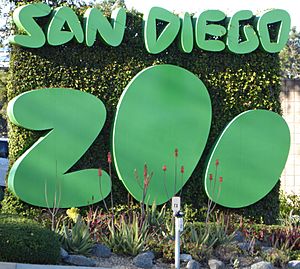
- Balboa Park Activity Center
- Balboa Park Carousel
- Balboa Park Club
- Balboa Park Lawn Bowling Greens
- Balboa Stadium
- Casa de Balboa
- Casa del Prado (home to the San Diego Youth Symphony and San Diego Junior Theatre)
- Electriquettes (old-fashioned electric carts you can ride)
- House of Pacific Relations International Cottages
- Morley Field Sports Complex (has a golf course, swimming pool, archery range, disc golf, and tennis courts)
- Municipal Gymnasium
- Old Globe Theatre
- Palisades Building (home to the Recital Hall and Marie Hitchcock Puppet Theater)
- San Diego Zoo (also runs the Balboa Park Miniature Train)
- Spanish Village Art Center (home to the San Diego Mineral and Gem Society)
- Spreckels Organ Pavilion
- Starlight Bowl
- War Memorial Building
- WorldBeat Cultural Center
Park Layout
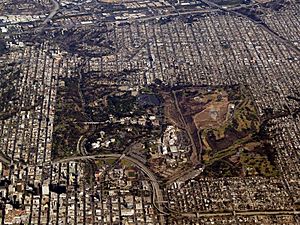
Balboa Park is shaped mostly like a rectangle. It has two main canyons, Cabrillo Canyon and Florida Canyon, which divide the park into three areas called mesas.
- The Sixth Avenue Mesa is a narrow strip on the park's western side. It has open grassy areas and tree groves.
- The Central Mesa is where most of the park's museums and cultural buildings are. This includes the San Diego Zoo and the Prado area.
- The East Mesa is home to Morley Field, where you'll find many sports facilities.
Some freeways cross through the park, including California State Route 163 and Interstate 5. The part of State Route 163 that goes through Cabrillo Canyon is known as one of America's most beautiful parkways.
The park is surrounded by many of San Diego's older neighborhoods, like Downtown and North Park.
Gardens and Trees
Balboa Park is a major attraction in San Diego. It has many old and rare trees, forming a beautiful urban forest. Many of the first trees were planted by Kate Sessions, a famous landscape architect and botanist. She loved drought tolerant plants and California native plants. She even had a nursery to grow plants for the park and the public.
Some of the beautiful gardens in the park include the Alcazar Garden, the Botanical Building, the Desert Cactus Garden, and the Japanese Friendship Garden.
Main Entrance and El Prado
The main way to enter the park is over the Cabrillo Bridge and through the California Quadrangle. This area was planned to be just for people walking, but it's currently used by cars too.
El Prado is a long, wide street that runs through the middle of the park. Most of the buildings along El Prado are in the Spanish Colonial Revival architecture style. This style mixes European Spanish designs with older Spanish Colonial designs from Mexico. Along this street, you'll find many of the park's museums and cultural spots, like the Museum of Us, the San Diego Museum of Art, and the Reuben H. Fleet Science Center. Other cool features along El Prado include the Reflection Pond and the beautiful latticed Botanical Building.
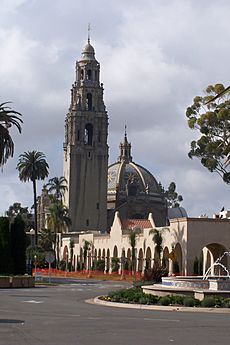
For shows and music, there's the Spreckels Organ Pavilion, which has one of the world's biggest outdoor pipe organs. The Old Globe Theatre complex includes a replica of Shakespeare's Globe Theatre. The Casa Del Prado Theater is home to San Diego Junior Theatre, the oldest children's theater program in the country. The House of Pacific Relations International Cottages also offer free shows.
The Botanical Building was built in 1915 for the Panama-California Exposition. It was the largest wooden structure of its kind in the world back then. It holds many large palm trees and other plants.
History of Balboa Park
Early History: Kumeyaay Village
Before Balboa Park was created, this area was home to a Kumeyaay village. This village was known as Hatam's Village and was located in Florida Canyon. It became a neighborhood for Native Californians and people from Baja California who were looking for jobs in San Diego. This community lasted until the 1890s before the park was fully developed.
Land Set Aside
In 1835, the Mexican government set aside about 1,400 acres of land in San Diego for public use. This land included what is now Balboa Park. This makes it one of the oldest places in the United States dedicated to public recreation.
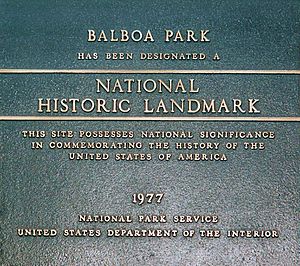
In 1868, city leaders decided to create a public park on this land. A resolution was passed to set aside 1,400 acres for a large city park. In 1870, a new law was passed that said these lands would be held "in trust forever" by the city for a park.
San Diego residents really loved the park. In 1871, some people tried to change the law so parts of the park could be sold. But the people of San Diego fought back, collecting signatures and making sure the park stayed intact. Their efforts worked, and the park was saved. San Diego was the second city in the U.S. to create a large park, after New York City's Central Park.
City Park: 1872–1909
For its first few decades, "City Park" was mostly open land with wildflowers and wildlife like bobcats and coyotes. Not much was built there until 1902.
However, some buildings did appear, like an orphanage and a high school. One of the most important early uses was a 36-acre plant nursery run by Kate Sessions. She is often called "the mother of Balboa Park." Kate Sessions brought many different kinds of native and exotic plants to the park. She was even the first woman to win a special award for bringing foreign plants to the U.S.
Other early additions included two reservoirs and a gunpowder storage building. The first fun things to do in the park were in the "Golden Hill Park" area. These included a children's park, walking trails, and a bird aviary.
Getting Ready for the 1915 Expo: 1910–1914
The preparations for the 1915 Panama–California Exposition gave Balboa Park much of its current look. In 1909, a San Diego business leader named G. Aubrey Davidson suggested holding an expo to celebrate the opening of the Panama Canal. He thought it would help San Diego grow and become more famous.
In 1910, "City Park" was renamed Balboa Park, after Vasco Núñez de Balboa, the first European to see the Pacific Ocean. San Diego was the smallest city to ever host a World's Fair, with a population of less than 40,000 people. The expo cost $5 million to start, with money from local businesses and voters.
The main designer for the expo was architect Bertram Goodhue. He chose a special style for the buildings called Spanish Colonial Revival architecture. This style used beautiful, detailed designs from Spanish and Mexican architecture. The buildings were very popular and helped make this style famous in California. One big improvement for the park was the Cabrillo Bridge, which connected different parts of the park.
The Panama-California Exposition: 1915–1916
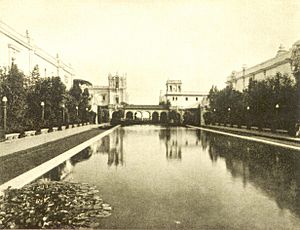
The Panama-California Exposition opened on December 31, 1914. President Woodrow Wilson symbolically opened the fair by pushing a button in Washington, D.C. The park was decorated with yellow and red colors, and over 40,000 red Poinsettia plants were used. The expo was a huge success and was extended through 1916. Over two years, it attracted more than 3.7 million visitors, including famous people like Henry Ford and Theodore Roosevelt.
Many of the buildings were only meant to be temporary. However, after the expo, people decided to keep them because they were so beautiful. Funds were raised to restore them. Some of the buildings and structures from this expo that are still in the park today include:
- Cabrillo Bridge
- California State Building and Quadrangle (now the Museum of Us)
- Botanical Building
- California Bell Tower
- New Mexico Building (now Balboa Park Club)
- Spreckels Organ Pavilion
California Pacific International Exposition: 1935–1936
Balboa Park hosted its second big event, the California Pacific International Exposition, in 1935. This expo aimed to help San Diego during the Great Depression. New buildings were added, some of which were meant to be permanent. These include the Old Globe Theatre, the International Cottages, and the Spanish Village.
Like the first expo, this one was very successful and was extended for a second year. President Franklin D. Roosevelt even visited. This expo had 6.7 million visitors, almost double the first one!
World Wars
During both World War I and World War II, Balboa Park was used by the United States Department of the Navy. It served as a place for soldiers to stay and train, and as an extension of the Naval Medical Center San Diego.
In World War I, over 5,000 U.S. troops used the park for training. A Marine base was set up there from 1914 to 1921. After the war, the Marine Corps returned the buildings in the same condition they received them.
During World War II, the park was called Camp Kidd. Buildings were used as hospital wards, training centers, and barracks. After the attack on Pearl Harbor, many wounded soldiers were brought to Camp Kidd's hospital. The park was given back to the city in 1946.
After the Wars: 20th and 21st Centuries
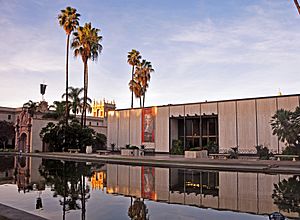
After the wars, new things were added to the park. A carillon (a musical instrument with bells) was added to the California Tower in 1946. The San Diego Junior Theater started in 1948. The outdoor theater, once called the Ford Bowl, became the Starlight Bowl, where Broadway musicals were performed outdoors in the summer.
In the 1960s and 1970s, several new museums opened, including the Timken Museum of Art in 1965 and the Reuben H. Fleet Science Center in 1973. The Food and Beverage Building from the 1915 expo was rebuilt and reopened as Casa del Prado in 1971.
In 1977, Balboa Park and its historic buildings were officially named a National Historic Landmark. Sadly, in 1978, two historic park buildings burned down in fires: the Aerospace Museum and the Old Globe Theatre. The Aerospace Museum (now the San Diego Air & Space Museum) moved to the old Ford Building. The Old Globe Theatre was rebuilt and reopened in 1981.
By 2001, over 12 million people visited the park each year. In 2017, California named Balboa Park a cultural district because of its important role in San Diego's culture.
Centennial Celebration
As the 100-year anniversary of the 1915 expo approached in 2015, there were plans for a big celebration. While a large-scale event didn't happen as first planned, many of the park's institutions held their own special exhibits and events. Volunteers also started an "Adopt-a-Plot" program to help make the park even more beautiful. In 2016, the Electriquettes, electric-powered wicker carts from the 1915 expo, returned to the park for people to rent and drive.
In 2017, it was announced that San Diego Comic-Con would open a museum in the park.
Special Events
Balboa Park hosts many events throughout the year. These include free weekly concerts at the Spreckels Organ Pavilion every Sunday. There are also annual parades, cultural festivals, and fairs.
- December Nights (originally "Christmas on the Prado") is a popular festival held in early December.
- EarthFair is one of the largest free environmental fairs in the U.S., held every April to celebrate Earth Day. It has a parade, music, and lots of information about the environment.
- The two-day San Diego Pride Festival takes place in July.
- A cherry blossom festival is celebrated every March in the Japanese Friendship Garden.
Many races and marathons also include the park in their routes, like the Foot Locker Cross Country Championships and the San Diego Rock 'n' Roll Marathon.
Images for kids
See also
 In Spanish: Parque Balboa para niños
In Spanish: Parque Balboa para niños


